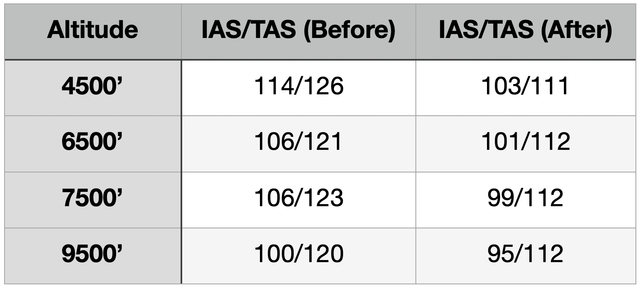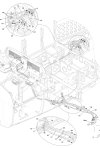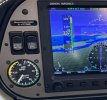kicktireslightfires
Pre-takeoff checklist
- Joined
- Jun 11, 2020
- Messages
- 348
- Display Name
Display name:
kicktireslightfires
I have a minor mystery of the universe on my hands. My airplane always flew at 120+ KTAS (120-126). Then one day, a few weeks ago, it began flying about 10 knots slower INDICATED and no one can figure out why. It's as if I'm now towing an open parachute while I fly. I have spoken to multiple A&Ps and everyone is stumped so I'm hoping maybe someone on here has a bright idea we haven't thought of.
As long as it's not against the rules here, I will send one $100 Starbucks or Amazon gift card (your choice) to whoever is the one who figures this out or prompts the question that figures this out! (Moderator: if this is against the rules, please just delete this section of my post rather than deleting the whole thing.)
It's a Rotax 912iS engine with about 500 hours SNEW, ground-adjustable prop, with Dynon SkyView D1000 Touch PFD and MFD. E-LSA (was S-LSA) low wing.
Same power setting, same RPM, same fuel, same altitudes, same weights.
At the bottom of this post is a table showing the before that I flew with for months after getting a new prop installed, and the after showing what I'm suddenly getting now and have been every day since it all started when we replaced the Dynon GPS antenna -- it had poor signal strength so we swapped it out for a new one. But we cannot identify any connection between replacing the GPS antenna and having the IAS being different.
The groundspeed is accurate -- I cross-compared it to the groundspeed my iPad and iPhone are showing so that's double verified.
The indicated airspeed showing on the PFD perfectly matches the standby airspeed indicator.
I just had a pitot test conducted and the $60,000 machine was pumping 120 knots into the pitot tube and my Dynon PFD was showing precisely 120 knots IAS. The pitot-static testing guy was also completely stumped by this mystery of how I have lost 10+ knots of airspeed. He did say while the pitot was perfect, I was registering a 200fpm leak on the static line, but for an unpressurized VFR-only airplane, it's meaningless.
Since I had a new prop installed a few months back, I also verified that the prop pitch didn't change (suspected not anyway because the RPMs were still all the same). Prop pitch is still exactly what it was when it was installed down to the tenth of a degree.
I thought maybe perhaps the engine is producing less horsepower despite the same RPM, but my A&P who is intimately familiar with Rotax says no.
EGTs are the same before and after.
I thought perhaps maybe I was always flying at these slower speeds and I was just seeing artificial speeds. But that can't be because my TAS was always accurate when I compared to the groundspeed and winds aloft, and my ETE times always bang on.
Next you might be thinking my winds aloft may have been inaccurate due to a calibration problem with my digital compass. But my ADAHRS primary and secondary were properly calibrated before this airspeed loss happened and while I was still flying at 120+ KTAS. So it couldn't be a compass calibration problem, either.
The only other thing changed was the rudder trim tab was given about 15 degrees more of angle to max it out as I was about half a ball out of coordination in cruise. That extra 15 degrees of deflection on the rudder trim tab got it a little better, but still about a quarter of a ball out when in cruise. YES, the extra rudder trim will add drag, but everyone I've talked to agrees there's no possible way it could cause 10 knots worth of drag and maybe just a knot or two. Is there anyone out there who thinks 15 or even 20 degrees of additional rudder trim angle could really slow the plane down by 10 knots? If so, I'd be very curious to hear your reasoning. The only reason we haven't bent it back the other way to test is because it's aluminum and if we bend it back and find it didn't bring the airspeed back, then we bend it BACK to how we had it, that will probably seriously weaken it and risk it snapping off. The rudder trim tab on my plane is already pretty aggressive. But the fact that I was flying at 120+ KTAS with it just ~15 degrees shy of it being maxed out makes me believe it's nearly impossible for just going ~15 degrees more to max it out equate to a 10 knot airspeed reduction.
Truly cannot figure this one out. Have spent many hours and hours and multiple sleepless nights racking my brain. I'd greatly appreciate any help as it just doesn't make any sense to anyone how an airplane can instantly lose so much airspeed.
Please hit me with every question you can think of so we can brainstorm this.

As long as it's not against the rules here, I will send one $100 Starbucks or Amazon gift card (your choice) to whoever is the one who figures this out or prompts the question that figures this out! (Moderator: if this is against the rules, please just delete this section of my post rather than deleting the whole thing.)
It's a Rotax 912iS engine with about 500 hours SNEW, ground-adjustable prop, with Dynon SkyView D1000 Touch PFD and MFD. E-LSA (was S-LSA) low wing.
Same power setting, same RPM, same fuel, same altitudes, same weights.
At the bottom of this post is a table showing the before that I flew with for months after getting a new prop installed, and the after showing what I'm suddenly getting now and have been every day since it all started when we replaced the Dynon GPS antenna -- it had poor signal strength so we swapped it out for a new one. But we cannot identify any connection between replacing the GPS antenna and having the IAS being different.
The groundspeed is accurate -- I cross-compared it to the groundspeed my iPad and iPhone are showing so that's double verified.
The indicated airspeed showing on the PFD perfectly matches the standby airspeed indicator.
I just had a pitot test conducted and the $60,000 machine was pumping 120 knots into the pitot tube and my Dynon PFD was showing precisely 120 knots IAS. The pitot-static testing guy was also completely stumped by this mystery of how I have lost 10+ knots of airspeed. He did say while the pitot was perfect, I was registering a 200fpm leak on the static line, but for an unpressurized VFR-only airplane, it's meaningless.
Since I had a new prop installed a few months back, I also verified that the prop pitch didn't change (suspected not anyway because the RPMs were still all the same). Prop pitch is still exactly what it was when it was installed down to the tenth of a degree.
I thought maybe perhaps the engine is producing less horsepower despite the same RPM, but my A&P who is intimately familiar with Rotax says no.
EGTs are the same before and after.
I thought perhaps maybe I was always flying at these slower speeds and I was just seeing artificial speeds. But that can't be because my TAS was always accurate when I compared to the groundspeed and winds aloft, and my ETE times always bang on.
Next you might be thinking my winds aloft may have been inaccurate due to a calibration problem with my digital compass. But my ADAHRS primary and secondary were properly calibrated before this airspeed loss happened and while I was still flying at 120+ KTAS. So it couldn't be a compass calibration problem, either.
The only other thing changed was the rudder trim tab was given about 15 degrees more of angle to max it out as I was about half a ball out of coordination in cruise. That extra 15 degrees of deflection on the rudder trim tab got it a little better, but still about a quarter of a ball out when in cruise. YES, the extra rudder trim will add drag, but everyone I've talked to agrees there's no possible way it could cause 10 knots worth of drag and maybe just a knot or two. Is there anyone out there who thinks 15 or even 20 degrees of additional rudder trim angle could really slow the plane down by 10 knots? If so, I'd be very curious to hear your reasoning. The only reason we haven't bent it back the other way to test is because it's aluminum and if we bend it back and find it didn't bring the airspeed back, then we bend it BACK to how we had it, that will probably seriously weaken it and risk it snapping off. The rudder trim tab on my plane is already pretty aggressive. But the fact that I was flying at 120+ KTAS with it just ~15 degrees shy of it being maxed out makes me believe it's nearly impossible for just going ~15 degrees more to max it out equate to a 10 knot airspeed reduction.
Truly cannot figure this one out. Have spent many hours and hours and multiple sleepless nights racking my brain. I'd greatly appreciate any help as it just doesn't make any sense to anyone how an airplane can instantly lose so much airspeed.
Please hit me with every question you can think of so we can brainstorm this.

Last edited:

 Merry Christmas!
Merry Christmas!

